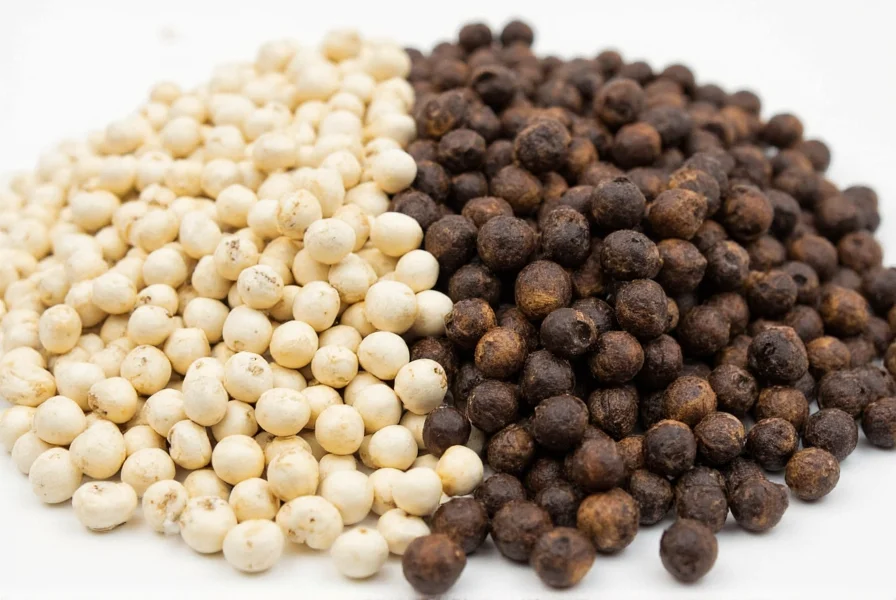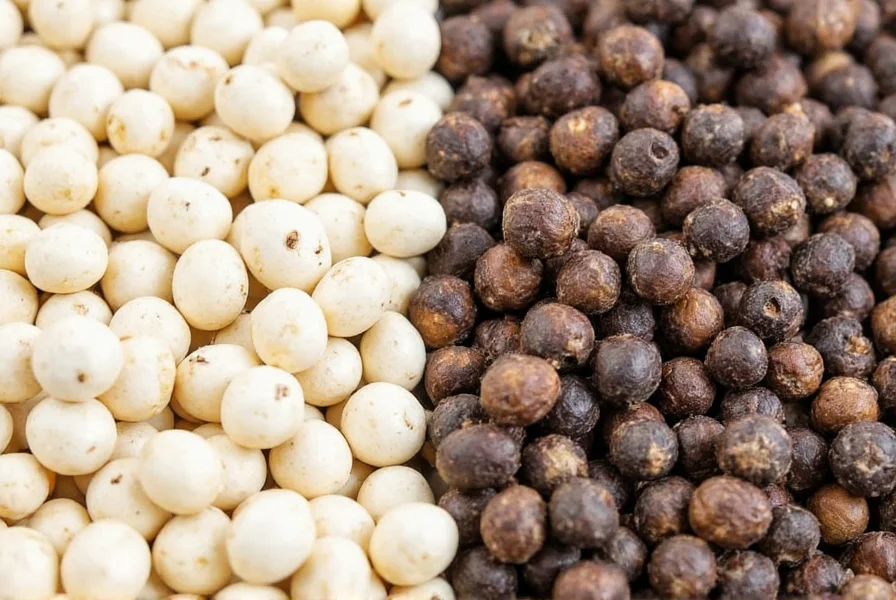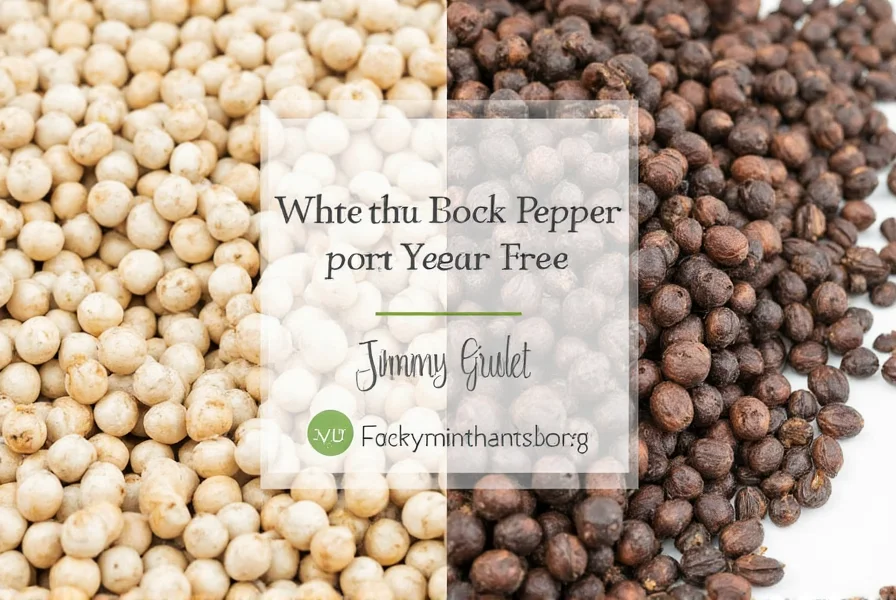The primary difference between white and black pepper lies in their processing method and resulting flavor profile. Black pepper comes from unripe green peppercorns that are cooked and dried, developing a bold, complex flavor with floral notes. White pepper is made from ripe peppercorns with the outer layer removed, yielding a milder, earthier taste. Black pepper contains more piperine (the compound responsible for pepper's heat), making it spicier than white pepper. Chefs choose between them based on desired flavor intensity and visual presentation in dishes.
Understanding the distinction between white and black pepper goes beyond mere appearance—it affects culinary outcomes, nutritional content, and historical significance. Both spices originate from the same plant, Piper nigrum, yet their processing methods create remarkably different end products that serve unique purposes in global cuisines.
Origins and Processing Methods
Despite coming from the same vine, white and black pepper undergo dramatically different processing:
| Characteristic | Black Pepper | White Pepper |
|---|---|---|
| Harvest Stage | Unripe green berries | Ripe red berries |
| Processing Method | Sun-dried after brief cooking | Soaked to remove outer layer, then dried |
| Outer Layer | Retained (turns black during drying) | Removed through fermentation |
| Production Time | Approximately 1 week | Several weeks of soaking |
Black pepper production involves harvesting unripe green peppercorns, briefly cooking them in hot water, and then sun-drying them for about a week. During this process, the outer layer turns black through enzymatic oxidation, similar to how an apple browns when exposed to air.
White pepper requires a more complex process. Fully ripe red peppercorns are soaked in water for 7-14 days, allowing the outer layer to ferment and loosen. The outer skin is then mechanically removed, leaving only the inner seed, which is dried to produce white pepper. This fermentation process contributes to white pepper's distinctive earthy flavor.

Flavor Profiles and Chemical Composition
The processing differences directly impact flavor chemistry. Black pepper contains approximately 5-9% piperine, the alkaloid responsible for pepper's heat and pungency, while white pepper contains slightly less at 4-7%. This makes black pepper noticeably spicier.
Black pepper offers a complex flavor profile with:
- Sharp, floral top notes
- Woody undertones
- Subtle citrus hints
- Noticeable heat that builds gradually
White pepper provides a different sensory experience:
- Milder initial heat
- Earthy, musty characteristics
- Less complex flavor profile
- More immediate but shorter-lasting pungency
These flavor differences explain why certain cuisines prefer one variety over the other. French cuisine traditionally uses white pepper in light-colored sauces where black specks would be visually disruptive, while Southeast Asian dishes often feature black pepper for its bolder flavor.
Culinary Applications and Pairing Guidance
Professional chefs select between white and black pepper based on specific culinary requirements:
When to Choose Black Pepper
- Rubs for meats, especially beef and lamb
- Dark sauces and gravies
- Roasted vegetable preparations
- Spice blends like garam masala
- Finishing dishes where visual specks are acceptable
When White Pepper Shines
- Creamy sauces (béchamel, alfredo)
- Light-colored soups (bisques, consommés)
- Seafood dishes where milder heat is preferred
- Traditional Chinese hot and sour soup
- German potato salad and other European potato dishes
Chef Marco Pierre White famously stated, "White pepper is the secret weapon of professional kitchens—it delivers heat without visual distraction." This principle guides many culinary professionals when deciding between pepper varieties.

Nutritional Differences and Health Considerations
Both pepper varieties offer similar nutritional profiles, but subtle differences exist:
- Black pepper contains higher levels of antioxidants due to the retained outer layer
- White pepper may be preferable for individuals with pepper skin sensitivities
- Both enhance nutrient absorption, particularly of turmeric's curcumin
- Black pepper shows slightly stronger anti-inflammatory properties in studies
Research published in the Journal of Agricultural and Food Chemistry indicates that black pepper's essential oils, largely removed during white pepper production, contribute additional health benefits including improved digestion and potential respiratory benefits.
Storage Recommendations and Shelf Life
Proper storage affects both varieties differently:
- Whole peppercorns (both types) maintain freshness for 2-3 years when stored in airtight containers
- Ground black pepper retains potency for 6-12 months
- Ground white pepper degrades faster, typically losing significant flavor within 4-6 months
- Both should be stored away from light, heat, and moisture
- Vacuum-sealed containers extend shelf life considerably
Food scientists recommend grinding peppercorns immediately before use for maximum flavor impact, as the volatile compounds responsible for pepper's aroma begin dissipating within minutes of grinding.
Common Misconceptions Clarified
Several myths persist about these pepper varieties:
- Myth: White pepper is "weaker" than black pepper
Reality: White pepper has comparable heat but different flavor notes that may seem milder - Myth: White pepper is artificially colored
Reality: The white color comes from removing the dark outer layer through natural fermentation - Myth: One variety is significantly healthier than the other
Reality: Both offer similar health benefits with minor differences in antioxidant content
Practical Selection Guide
When choosing between white and black pepper, consider these factors:
- Visual requirements: Will black specks disrupt the dish's appearance?
- Flavor intensity: Does the recipe need bold pepper notes or subtle heat?
- Culinary tradition: Does the cuisine traditionally use one variety?
- Heat tolerance: Are you cooking for people sensitive to strong spices?
- Recipe age: Older recipes often specify white pepper for visual reasons
For home cooks exploring the difference between white and black pepper, culinary expert James Peterson recommends starting with black pepper for most applications, then experimenting with white pepper in light-colored sauces to appreciate the subtle distinctions.











 浙公网安备
33010002000092号
浙公网安备
33010002000092号 浙B2-20120091-4
浙B2-20120091-4